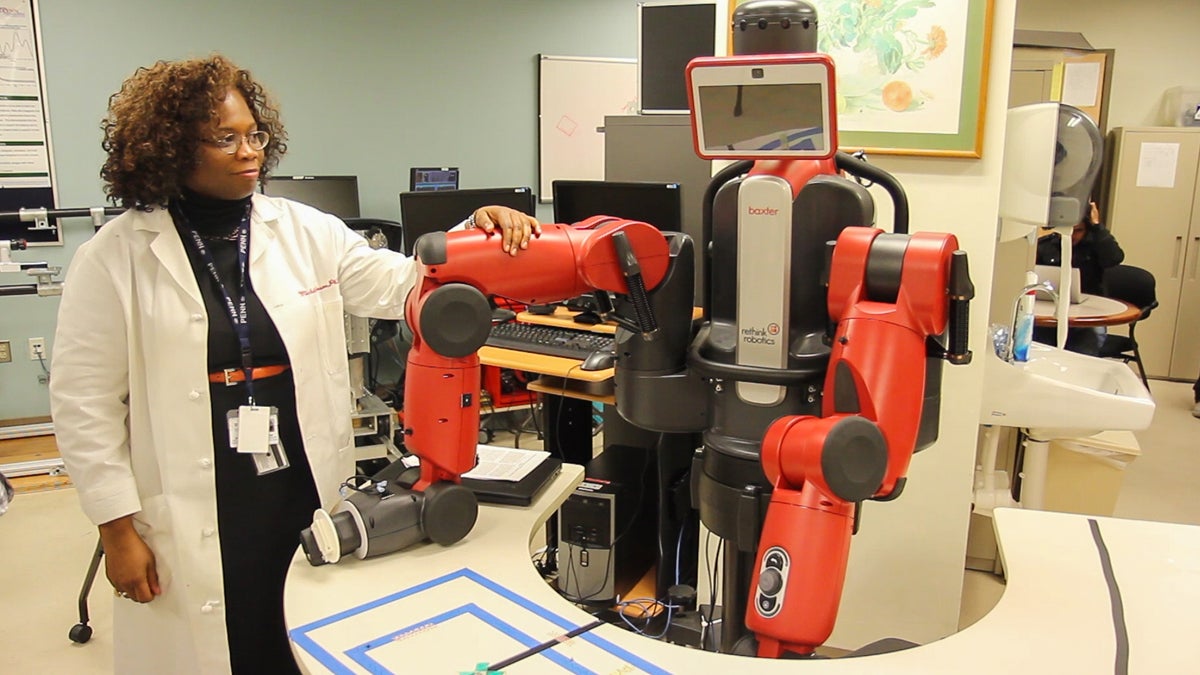How robots could revolutionize rehabilitation

(Ifanyi Bell/for WHYY)
Now more than ever, it seems, robots and automation are taking a more prominent role in places where humans are either unwilling or unable to perform. Autonomous robots are already sweeping up after us, heating our homes efficiently, and will soon be delivering our mail and driving us from point A to point B. And it doesn’t stop there. One University of Pennsylvania researcher believes that the robot revolution is poised to enter into an arena that many think is dependent upon the human touch.
On a visit to her lab, at Good Shepherd Penn Partners, Michelle Johnson showed us some of the basic prototypes that she is developing to one day aid you on your way to recovery from any number of debilitating injuries.
Johnson says the technology that is available on the market already brings us halfway there; it’s just a matter of designing software and algorithms that can support some existing hardware. For some of the hardware, she points to a somewhat unlikely resource.
“Interestingly enough, the video game industry has really allowed us to open up new possibilities in the rehabilitation space,” she explained.
Johnson identifies technology developed for the video gaming industry where it allows for game systems to interact with players. The technology powering gaming peripherals like the Microsoft Kinect and the motion sensing Nintendo Wii controller have already found applications outside of the video game industry and the same tools can serve as a link between robot systems and patients, giving robots the ability to accurately sense motion and detect biometric data.
These tools, in conjunction with other hardware like the NAO robot, developed by robotics company Alderbaran, combine to form a very potent platform that is ideal for instructional rehab support.
Dr. Johnson imagines that the NAO robot’s human-mimicking characteristics could be deployed to guide patients in rehabilitation exercises during times when human staff is unavailable.
Her lab is hard at work developing the very complicated algorithms that will serve as the brains that will link these systems together and guide how they interact with patients.
In this edition of “So, What Do You Do?,” our interviewer, Keith Irwin, asked Johnson about when we would start to see robots nursing us back to health.
“We’re actually already there,” said Johnson.
“There are a couple of robot systems that were developed at MIT and some other places that are actually already being used in rehab settings,” she explained.
“Here at the rehab center, we have ‘Ekso.’ Ekso Bionics makes a robot for the lower limbs that helps people with spinal cord injuries get up and walk, so we have those here.”
Though there are some robot systems that are already commercially available, Johnson’s goal isn’t necessarily to see a robot in every home. At least not yet.
“I’m a researcher at heart. I may not be looking at the commercial space of getting my robots in people’s homes, but I’m looking at what would it take to get these robots there and developing algorithms and developing new systems that may one day end up in this environment. “
Instead of the commercial market, Johnson envisions support robot systems being delivered to remote locations where certain communities lack the personnel to manage a certain level of rehabilitation care.
“Right now we are partnering with different countries, not necessarily to get them into people’s homes, but to get them to areas where maybe patients can’t necessarily get to the hospital, but they can get to satellite locations where these systems are set up.’
Johnson stresses that her lab’s concepts are not intended to replace human beings, but are rather set up as a support and reinforcement of the ideas that trained, human therapists develop.
WHYY is your source for fact-based, in-depth journalism and information. As a nonprofit organization, we rely on financial support from readers like you. Please give today.



